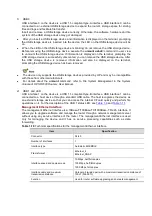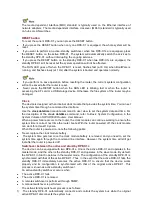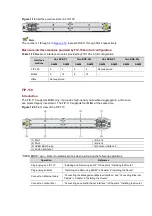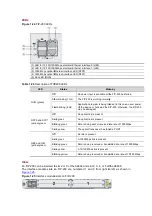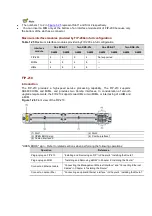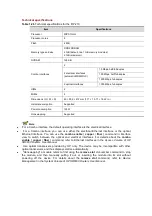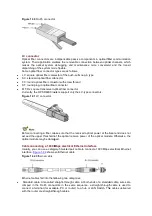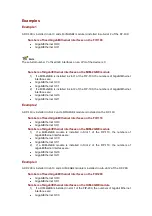
The numbers 1 and 2 in
Figure 1-28
represent Slot 1 and Slot 2 respectively.
You can insert a MIM only at the bottom of an interface module slot of FIP-210 because only
the bottom of the slot has a connector.
Maximum interface modules provided by FIP-210s in full configuration
Table 1-28
Maximum interface modules provided by FIP-210s in full configuration
Interface
module
One RPE-X1
Two RPE-X1s
One RSE-X1
Two RSE-X1s
A6604
A6608
A6604
A6608
A6604
A6608
A6604
A6608
FIP-210
2
4
2
4
2
4
1
3
MIMs
4
8
4
8
4
8
2
6
HIMs
4
8
4
8
4
8
2
6
Detailed Descriptions of FIPs
Ethernet interface introduction
The FIP of the device provides two Combo interfaces, each of which consists of an electrical
Ethernet interface and an optical Ethernet interface. The default operating interface is the
electrical Ethernet interface.
For the rate and duplex mode when the electrical Ethernet interface is operating, see
Table 1-
29
.
Table 1-29
Rate and duplex mode when the electrical Ethernet interface is operating
Rate
Duplex mode
10 Mbps
Half/full-duplex auto-negotiation
100 Mbps
Half/full-duplex auto-negotiation
1000 Mbps
Full-duplex
The electrical Ethernet interface LEDs are above the RJ-45 ports. The LEDs in triangle and
inverted triangle indicate the status of the lower and upper electrical Ethernet interfaces,
respectively. For the description of the electrical Ethernet interface LEDs, see
Table 1-18
,
Table
1-21
,
Table 1-24
, and
Table 1-27
.
The optical Ethernet interface supports 1000 Mbps in full-duplex mode. The optical Ethernet
interface LEDs are on the left of the two Combo interfaces and use separate LEDs to indicate
the status of the corresponding optical Ethernet interfaces. For the description of the optical
Ethernet interface LEDs, see
Table 1-18
,
Table 1-21
,
Table 1-24
, and
Table 1-27
.

